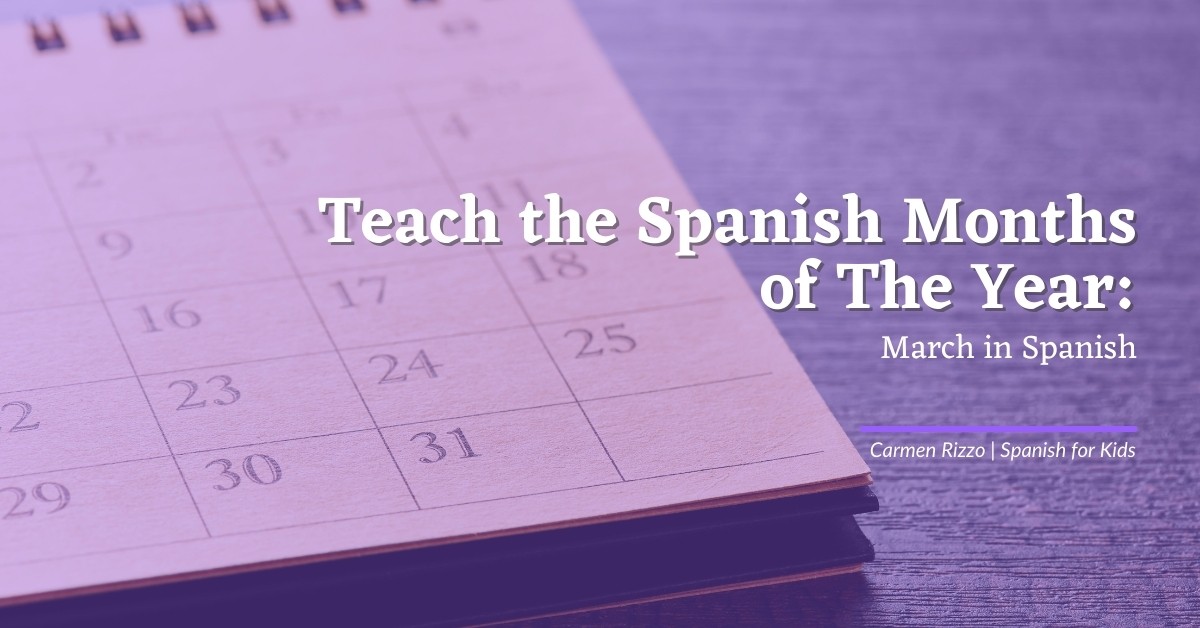
Teach Spanish Months of the Year: March in Spanish
Marzo, or March in Spanish, is the third month of the year full of changes, commemoration, and celebrations.
The name of this month comes from the latin “Martius,” which was the first month of the old Roman calendar, named after the god Mars. In time, the name “Martius” evolved to March in English and marzo in Spanish.
March is a month of seasonal transition, with the beginning of spring in the northern hemisphere and fall in the southern hemisphere. Also, there are many important commemorations to celebrate and talk about when teaching about March in Spanish.
Weather of March in Spanish
March brings with it many weather changes around the world. The two major season changes during this month are:
- La primavera – spring
- El otoño – autumn/fall

La Primavera
La primavera (spring) is the season that follows the cold and gloomy winter months—giving way to warmer weather, sunny days, and warm rain! In many countries (mostly in the northern hemisphere) spring begins on the first day of March.
Bring your lesson about spring to life by using these vocabulary words related to March in Spanish:
| Spanish | English |
| La primavera | spring |
| Despertar | to wake up |
| Los insectos | Insects |
| La abeja | Bee |
| El abejorro | Bumblebee |
| La miel | Honey |
| La mariquita/ La catarina | Ladybug |
| La oruga | Caterpillar |
| La mariposa | Butterfly |
| El caracol | Snail |
| El cienpies | Centipedes |
| La libelula | Dragon-fly |
| El escarabajo | Beetle |
| La flor | Flower |
| El campo de flores | Field of flowers |
| Florecer | To bloom |
| La polinización | Pollination |
| Polinizar | To pollinate |
| La rosa | Rose |
| La margarita | Daisy |
| La flor de jacaranda | Jacaranda flower |
| El girasol | Sunflower |
| La flor de cerezo | Cherry Blossom |
El Otoño
El otoño (fall or autumn) is a season of cool and comfortable weather after summer that precedes the coldest days of winter. While in the northern hemisphere the month of March means spring, in the southern hemisphere, it means autumn and cool weather. Here are some words that you may hear and read in Spanish when talking about March in Spanish in the southern hemisphere:
| Spanish | English |
| El otoño | Fall/Autumn |
| Las hojas secas | Dry leaves |
| El clima fresco | Cool weather |
| El viento | Wind |
| El frío | Cold |
| Las nubes grises | Grey clouds |
| El cielo nublado | Cloudy sky |
| La ropa de otoño | Fall/Autumn clothes |
| La bufanda | Scarf |
| Los guantes | Gloves |
| Las botas | Boots |
| El abrigo | Coat |
| El sueter | Sweater |
| El sudadero/ La sudadera | Hoody |
| Las bebidas calientes | Hot beverages |
| Acogedora/Acogedor | Cozy |
On March 19 to 21, every year, an astronomical event takes place and signals the “official” beginning of spring and fall: the equinox.
Read more: How the March Equinox Differs in Northern and Southern Hemispheres
Check out these useful vocabulary words to discuss this amazing natural event in Spanish:
| Spanish | English |
| El equinoccio | Equinox |
| Astronómico | Astronomical |
| Fenómeno astronómico | Astronomical phenomenon |
| El eje terrestre | The earth’s axis |
| Otoñal | Autumnal |
| Primaveral | Springtime |
| La orbita | Orbit |
| Los fenómenos Celestes | Celestial phenomena |
| Astronomo | Astronomer |
| Los Astros | Stars |
Also, you can’t talk about March in Spanish and the equinox without mentioning the city of Chichen Itzá!
If you ever travel to the ancient Mexican city of Chichén Itzá in the Yucatan Peninsula during the spring equinox, near March 21, you will witness one of the most amazing uses of shadows and buildings by the Mayans. When the sunlight shines over certain parts of the Kukulcán castle, around 4 in the afternoon during those days, the shadow cast appears as if it were a snake descending on the stairs of the pyramid.
Celebrations During March in Spanish
March is a month full of celebrations and commemorations around the world. Let’s see what’s happening in Latin America and Spain during this month:
El Mes de San José
In Spain and several Latin American countries, March is the month to celebrate and commemorate San Jose de Nazaret, known as Saint Joseph. San José is the patron saint of the family and his nickname is el santo silencioso, which means “the quiet saint.”
In Spain el día de San José, or the day of Saint Joseph, is on March 19, which is the same date for el día del padre (father’s day) and el día del carpintero (carpenter’s day), due to the fact that San José was both a good father and a carpenter.
People celebrate San José with masses and processions throughout the month of March.
Día Internacional de la Mujer
El Día Internacional de la Mujer (International Women’s Day) is an important day in March in Spanish-speaking countries and elsewhere. This commemoration takes place on March 8 every year to raise awareness toward violence against women, the challenges of being a woman in several parts of the world, and to promote equal rights for girls and women.
El Día Internacional de la Mujer is widely celebrated around the world, and in Latin America and Spain there are several different ways to commemorate this important date. In most places people give flowers, cards, candies and other small gifts to women to show their appreciation. During this month, businesses give special discounts to women or target them as their primary audience and consumer.
On the other hand, women and female artistic and social collectives use this date to bring attention to the need of justice and protection for females through social activities like concerts, marches, collective dances, and even protests.
Here are some words in Spanish to use when talking about the Internationals Women’s Day:
| Spanish | English |
| Las mujeres | Women |
| Protestar | To protest |
| Conmemorar | To commemorate |
| La danza interpretativa | Interpretative Dance |
| La equidad de derechos | Equal rights |
| Las niñas | Girls |
| Las marchas del 8 de Marzo. | March 8 marches. |
El Día de San Patricio
Saint Patricks Day is a really popular celebration in the United States and Ireland, but to many people’s surprise it is also celebrated in Mexico and Argentina!
This is how this iconic holiday is commemorated in these two Latin American countries:
Argentina
In Argentina there is the 5th largest Irish colony of the world. To celebrate el Día de San Patricio families and friends get together to enjoy Irish food and drinks, alongside Irish music and a really great festive spirit. In Buenos Aires, Argentina’s capital, people celebrate with a huge and fun parade. Argentina and Ireland share a good political relationship and that reflects even on the celebrations!
México
In Mexico, el Día de San Patricio is commemorated differently because besides the normal celebration, like in other countries, in Mexico people also remember al Batallon de San Patricio, a group of european immigrants, mostly Irish, that fought alongside Mexican troops when the United States invaded Mexico in 1846. Since 2016, there has been a parade in Mexico City to commemorate those that fought in that battle and it ends with a music festival and a lot of fun!
Learn more: Interesting Facts About St. Patrick’s Day in Latin America
Here are some common words that relate to this festivity as you discuss celebrations in March in Spanish:
| Spanish | English |
| Santo | Saint |
| Trébol | Clover |
| Irlandés | Irish |
| Buena Suerte | Good Luck |
| El oro | Gold |
| El Trébol de tres hojas | Three leaf clover |
Activities to Do in March
As you can see, March is full of fun celebrations! And what is a better way to celebrate this amazing third month of the year with some fun and interesting activities? Here are some ideas on what to do:
Saint Patrick’s Ice Cream Float
This one is to enjoy with the whole family! Is there a better way to celebrate St. Patrick’s than with a green beverage? I think not! Take a look at this easy recipe on how to drink a fun and green drink to celebrate!
Ingredientes:
Soda o gaseosa de lima-limón (1 lata por cada persona en la familia)
1 galón de helado de vainilla
Colorante vegetal color verde
1 lata de Crema Batida
Chispas de dulce
Instrucciones:
En un vaso alto servir una o dos bolas de helado. En otro vaso servir con cuidado la soda y agregar de dos a tres gotas de colorante vegetal verde. Revolver con cuidado. Una vez la soda esté de color verde, vertir sobre el otro repiente con el helado. Servir con crema batida y decorar con chispas de dulce. Tomar con pajilla.
Ingredients:
Lime-lemon Soda (1 can for each person in the family)
1 gallon of vanilla ice-cream
Green food colorant
1 can of whipped cream
Candy sprinkles
Instructions:
In a tall glass, serve one or two scoops of ice-cream. In another glass, carefully serve the soda and add two to three drops of green food coloring. Stir carefully. Once the soda is green, pour over the other bowl with the ice cream. Serve with whipped cream and decorate with sprinkles. Drink with a straw.
Learn a Short and Sweet Poem
March is the beginning of Spring and that alone inspires a lot of people to create art. This sweet and short poem by Mari Carmen Díez Navarro is a perfect example of that. Why not learn it and share it with those you love?
Versos del mes de marzo
agrisados de dulces
rosas de cuarzo.
Versos de primavera
con sabor a los tibios
besos de la abuela.
Versos del mes de marzo,
murmullo de cariños
de arriba abajo.
Versos de primavera,
cargados de violetas
y de acederas.
Now in English:
Verses of the month of March
gray with sweets
quartz roses.
Spring verses
flavored like warm
Grandma kisses.
Verses of the month of March,
murmur of affection
from up to down.
Spring verses,
loaded with violets
and sorrel.
Read something different for bedtime!
What is the best way to commemorate women in the month that celebrates them? Talking about them! The best way to learn how others have impacted the world is reading about them. Good Night Stories for Rebel Girls: 100 Tales of Extraordinary Women comes in the form of bedtime stories and focuses on 100 women who have changed the world.
Read the Spanish version: Cuentos de buenas noches para niñas rebeldes.
¡Juguemos una ronda!
Springtime is perfect to begin to exercise and get more physical activity. Kids love being able to run and exercise outside, and the best way to play with them is with una ronda (a round game) which normally involves a song, and a lot of running!
Here is an easy one to help practice your Spanish:
Instructions:
Choose one child to be la ranita (the little frog) and have them stand in the middle of the circle. Get the other participants in a circle and tell them to hold hands and begin to walk in circles around la ranita. While they walk, they sing this:
Vamos a la vuelta del Toro Toronjil,
A ver a la rana, comiendo perejil.
La rana no esta aquí, estará en su vergel
Cortando una rosa, sembrando un clavel.
(English:)
Let’s go around the Toronjil Bull,
To see the frog, eating parsley.
The frog is not here, it will be in its garden
Cutting a rose, planting a carnation.
Then, the kids that form the circle stop and ask:
¿Cómo amaneció la ranita?
How did the little frog wake up?
And the child who is la ranita answers similar to:
- ¡Alegre! (Happy)
- Aburrida (Bored)
- Triste (Sad)
- ¡Enojada! (Angry)
After each answer, the kids sing the first part of the song again and la ranita answers again. After several rounds, the child who is la ranita can answer saying:
- ¡Engusanada! (gobbled up by a worm!)
The kids in the circle have to run around while la ranita tries to catch one of their friends. The child who gets caught becomes the new ranita and it’s time to play again!
You can learn the song here. View this video as an example of how to play.
Use your Spring Break Wisely and Practice Your Spanish!
Spring is a season that makes us feel invigorated and full of new goals and energy. Use all that energy to practice your fluency and learn more Spanish! Sign up today for a personalized 1-on-1 class with a native Spanish speaker from Guatemala and become part of more than 24,000 monthly active students at HSA! We offer flexible schedules, tailored Spanish packages, and high school Spanish credit with transcripts. Join us today!

Want more free Spanish lessons, fun content, and easy learning strategies for kids? Check these out!
- 100 Easy Spanish Words for True Beginners
- Earth Day Projects for Kids + Spanish Earth Day Vocabulary
- How to Talk About the Temperature in Spanish: Fahrenheit, Celcius, and Descriptions
- Car Parts Spanish Vocabulary List: Learn Using Pictures
- Top 15 New Year’s Resolutions in Spanish
- Talk About Hurricanes And The Weather in Spanish
- Spanish Words with Multiple Meanings in Latin America
- World Mental Health Day: A Vocabulary Guide for Mental Health Workers
- An Easy Vocabulary Guide to Describe the Post Office in Spanish - February 10, 2023
- Guatemala’s Biggest, Most Colorful Market: Chichicastenango - December 28, 2022
- 8 Sad Spanish Songs for When Your Heart Is Broken - December 6, 2022




